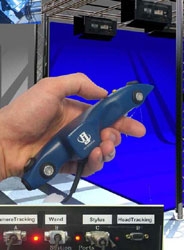 |
Abstract: Avatars for Co-located Collaborations in HMD-based Virtual Environments [DE]
Nico Brettschneider, Avatars for Co-located Collaborations in HMD-based Virtual Environments, Hochschule Düsseldorf, Bachelor thesis, 31.8.2018.
Through constant technical progress, multi-user virtual reality is transforming towards a social activity that is no longer only used by remote users, but also in large-scale location-based experiences. Thereby, the usage of realtime-tracked avatars in co-located business-oriented applications in a “guide-user-scenario” has not been scientifically evaluated yet in related literature. This thesis examines the effect of a realtime tracked avatar-guide on the user-related factors of Spatial Presence, Social Presence, User Experience and Task Load in order to propose design guidelines for co-located collaborative immersive virtual environments (IVEs). Therefore, an application was developed and a user study with 40 participants was conducted in order to compare both guiding techniques of a realtime-tracked avatar guide and a non-visualised guide with otherwise constant conditions. Results reveal that the avatar-guide enhanced and stimulated communicative processes while facilitating interaction possibilities and creating a higher sense of mental immersion for users. Furthermore, the avatar-guide appeared to make the storyline more engaging and exciting while helping users adapt with the medium of virtual reality. Even though no assertion could be done concerning the Task Load factor, the avatar-guide achieved a higher subjective value on User Experience. Due to the results, avatars can be considered valuable social elements in the design of future co-located collaborative IVEs.
Keywords:
Virtual Reality, Co-located Collaborations, Networked Immersive Virtual Environments, Head-mounted Display, Avatars, Social Presence
Supervisor:
Prof. Jens Herder, Dr. Eng./Univ. of Tsukuba
Jeroen de Mooij, B. Sc.
Location:
The research took place at the Burmester Event- und Medientechnik GmbH, Berlin.
|
 |
